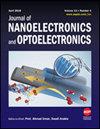4T Complementary Metal Oxide Semiconductor Image Sensor Charge Transfer Efficiency Optimization
IF 0.6
4区 工程技术
Q4 ENGINEERING, ELECTRICAL & ELECTRONIC
引用次数: 0
Abstract
4T CMOS image sensors are widely used in various imaging fields by virtue of low noise, high integration and low cost, but their pixel cells are manufactured with non-ideal effects causing trap energy levels and potential deviations, resulting in incomplete charge transfer of photogenerated signals, thus producing image trailing and affecting the imaging effect. Traditionally, the improvement of charge transfer efficiency is only limited to the optimization of one or two parameters or the optimization of the working state. In this paper, we propose a more systematic research method to optimize the charge transfer efficiency through five aspects: TG channel threshold voltage injection adjustment, PPD N-type impurity injection dose and injection angle, as well as TG operating voltage and FD reset voltage, respectively. The optimal process state and operating conditions are obtained: TG channel injection dose of 8.0 e12 cm−2, PPD N-type impurity injection dose of 3.0 e12 cm−2, injection angle of −4°, TG operating voltage of 2.7 V and FD reset voltage of 3.9 V, where the residual charge in the signal transfer path is minimal, and the design method in this paper has some guidance for the design of CIS pixels.4T互补金属氧化物半导体图像传感器电荷转移效率优化
4T CMOS图像传感器由于低噪声、高集成度和低成本而被广泛应用于各种成像领域,但其像素单元的制造具有非理想效应,导致陷阱能级和电位偏差,导致光生信号的电荷传输不完全,从而产生图像拖尾并影响成像效果。传统上,电荷转移效率的提高仅限于一个或两个参数的优化或工作状态的优化。本文提出了一种更系统的研究方法,分别从TG通道阈值电压注入调节、PPD N型杂质注入剂量和注入角度、TG工作电压和FD复位电压五个方面优化电荷转移效率。获得了最佳工艺状态和操作条件:TG通道注入剂量为8.0 e12 cm−2,PPD N型杂质注入剂量为3.0 e12 cm–2,注入角度为−4°,TG操作电压为2.7V,FD复位电压为3.9V,其中信号传输路径中的残余电荷最小,本文的设计方法对CIS像素的设计具有一定的指导意义。
本文章由计算机程序翻译,如有差异,请以英文原文为准。
求助全文
约1分钟内获得全文
求助全文
来源期刊

Journal of Nanoelectronics and Optoelectronics
工程技术-工程:电子与电气
自引率
16.70%
发文量
48
审稿时长
12.5 months
 求助内容:
求助内容: 应助结果提醒方式:
应助结果提醒方式:


